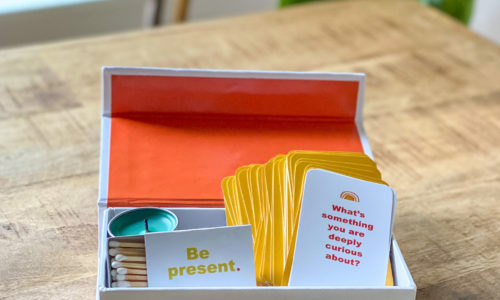I’ve been asked to release a tidbit of my book, Learning to Grow – How Acton Academy Turns Learning Upside Down, which will be available in less than a month. I hope you enjoy The Introduction as a teaser even though it’s much longer than a blog post should be:
“I can’t draw,” I said to my husband, Jeff.
“Yes, you can,” he said. “Turn the image you are trying to draw upside down. Now draw exactly what you see. Your left brain quiets down. Its rational language and organizing directives will allow your right brain to take over, releasing you from your judging, analytical self. No longer will you feel bound by ‘it’s a chair’ and feel the stress to draw the perfect chair. Try it!”
This exercise, developed in the late 1970s by Betty Edwards and written up in her book Drawing On the Right Side of the Brain, changed everything about my understanding of learning to draw. I discovered a new part of myself by turning the image of my subject matter upside down.
This change of perspective reminded me of Maria Montessori’s insistence on having “fresh eyes” each day when working with children—the ability to strip one’s own judgment and to observe clearly and freshly, so the person being observed remains free from your prejudices, opinions, and moods.
It is with this spirit of embracing new perspectives that Jeff and I entered the world of education in 2008: upside down and with fresh eyes.
We are products of America’s public school system. We each have memories of that “magical teacher” who changed our lives. We each received post-college degrees from traditional, private universities. And we each pursued education as a part of our own professional paths.
Despite our backgrounds in education, we never set out to start our own school or design something brand new in the K–12 realm. It was only when we had children of our own that things changed. We understood the world our children would face would be vastly different—unimaginably so—from the world we encountered as young adults. We knew they’d need to be armed to know how to learn, respond, innovate, and create in their own way rather than become skilled at taking tests and following instructions like we had. We believed our children would need the light of curiosity burning brightly in their eyes—not just when they were young learners, but throughout their childhood, teen years, and far beyond.
A small, quiet voice started creeping into our hearts as we looked for school options that would equip them for this wide-open, futuristic territory for which we had no compass. What had worked for us as children looked desperately outdated, impractical, and simply wrong, even with good, smart people working hard to make the traditional schools adaptive to today’s opportunities.
With no map or long-term strategic plan, we set out in the way artists and scientists do—disciplining ourselves to let go of preconceived ideas, experimenting without demanding outcomes, and using clear principles with standards of excellence to constrain us at every turn. Our goal? To create and bring to life a vision of “school” that worked for our own children and anyone who would join us. We didn’t want to disrupt or compete with traditional public or private schools. We wanted to run parallel to them.
While we sought data and results, our journey was fueled by a power not mentioned in academic spheres as part of the education equation.
Like all parents, we were driven by love. Love of the human spirit, of freedom, of learning, of risky adventure, and of responsibility. Love for our own children and the light in their eyes.
We wondered: Can a vision of school rationally encounter the power of love and claim it?
We found: only when the vision of school is turned upside down.
Acton Academy is the outcome of our dreaming and scheming. It is a new vision of what a learning community can be. It is gritty and dreamy. It is not for the faint of heart, because it inspires growth and transformation—neither of which are achieved without some suffering, which is the Latin root of the word passion.
With almost a decade under our belts, we can claim that Acton’s method of learning works. We have proof, which I will reveal in the pages ahead.
This book is the story of Acton Academy’s origin. Although it began as an ambitious extension of homeschooling, Acton has now grown into a worldwide community of over 800 students in more than sixty locations in eight countries, and it’s growing every week. Many communities are small—not more than 7 to 10 students—because they have only recently opened. The more mature locations are nearing a maximum size of 120 young people and are already spawning new communities. We currently have 5,300 applications in our pipeline from parents around the world wanting to open one for their own children. Our small school is set up as a not-for-profit 501(c)(3) organization driven by efficiency and accountability in operations so that the focus remains on our mission.
Our school model includes Socratic questions to hone deep thinking; peer teaching; apprenticeships for real-world learning; and state-of-the-art online learning for mastering the basics of reading, grammar, and math. Hands-on projects designed with game-theory incentives deliver opportunities for young people to dig into the arts, sciences, world history, and economics. Although we can translate the achievements of our students into a traditional transcript that proves mastery, the end goal of learning at Acton isn’t to get a good score on a test or an A from a teacher. It is something quite different and includes solving real problems, analyzing moral dilemmas, making difficult decisions, persuading audiences to action, creating innovative opportunities for the world, resolving personal conflicts, and even making and managing money.
The ultimate goal, though, is to learn how to learn, learn how to do, and learn how to be, so that each person who enters our doors will find a calling and change the world. Each person who graduates from an Acton Academy will be equipped to master the next step in their life plan with gusto—whether it be attending a fine university, taking a gap year to travel, or starting a business.
As I take you through our story, you’ll experience the physical environment of Acton, which is designed like a one-room schoolhouse, with ages mixed so that peers can learn from and teach one other. You’ll also experience the emotional engagement of our young people and taste how freedom feels for children. Because there are mountains of stories and experiences I could share from these years, I’ve had to condense the pieces, moving some of the projects and discussions out of chronological order. But the tale is true and yours for the taking.
Some people say what we are doing isn’t really all that different. True, there are excellent school models in the public and private sectors emerging around the country that use similar approaches, including teachers who are fueled by love for children and learning.
But there are a few distinguishing aspects of Acton that separate us from any other school model, and they are the reason for our strong outcomes. They also cause consternation in those who witness Acton in action. It’s hard to believe it’s real until you see it.
Our biggest point of separation is the upside-down power structure that pushes control and decision making to the children. We have few adults serving as bureaucratic authority figures around our learning environments. We believe adults in such capacity can stymie learning and that peers have more power. Because of this, we are free from the traditional trappings that have come to be known as “school.” Acton Academy has no teachers, only guides. No report cards, only student-earned badges and portfolios to prove mastery of skills. No classrooms, only creative work spaces called studios. No assigned homework, only what a child chooses to continue doing at home. No attendance requirements. No bureaucracy, only a lean machine that drives the cost of private schooling down to lower costs than any model we’ve seen.
Read on; you’ll be surprised.
Visit an Acton Academy and you won’t hear an announcement over an intercom by a principal, nor will you see a teacher managing behavior at recess. You won’t hear buzzers marking the end of math work time or science class.
This radical power shift does not mean children are running wild with no accountability or discipline, although there are days when chaos reigns. The Acton story is most surprising in that this power shift unleashes children to care so deeply about their learning that they choose to work hard, hold tight boundaries for each other, and rise to excellence in ways we never imagined. Self-imposed rigor is integral to our daily life.
Acton Academy is grounded in trusting children and believing they can handle big responsibilities. “It’s always opposite day at Acton,” an eight-year-old named Ian told me one day.
Through the ambiguity and messiness of life and learning, which we adults tend to abhor, we see children rise up and embrace the mindset of heroes—people who take responsibility for their choices, get back up after falling down, and refuse to quit even when it’s hard. We see children learning how to learn and loving it.
A second distinguishing characteristic of our school brings vibrancy to the upside-down canvas we’ve painted. It’s the landscape on which our curriculum is grounded and is our “why” behind everything that happens in a day, week, or year. It is the Hero’s Journey.
This grand mythological narrative of an ordinary person leaving a place of comfort to meet a challenge describes what all humans since the beginning of time have yearned for in life. We crave a life that means something to the world. We crave being known for our uniqueness, not what others expect or hope us to be. The Hero’s Journey beckons each of us to answer the questions: Who am I? Why am I here? Will I step forward to answer the call to adventure—knowing there will be monsters to battle, dark valleys to cross, and mountains to climb? Will I be passive or active about the direction of my life? Can I find the treasure of my potential, the holy grail, and return home with it to help others? Disney uses this narrative well to draw young hearts in, as do all great writers and storytellers. The Hero’s Journey crosses cultures and binds us as a tribe.
Children at Acton Academy know why they are being challenged to learn, to master, to solve, to forgive, to apologize, to discuss. They are doing so because it is part of their personal quest—their Hero’s Journey—to find their greatest treasures, their inner gifts, and hone them in order to solve a burning need in their community, city, or world.
At Acton, we talk about this magnificent journey often. Whether it’s learning multiplication or engaging in a heated match of GaGa ball, there is a clear and important reason that urges us forward. People in our community—from six-year-olds to sixty-year-olds—embrace the challenge to learn and grow, knowing there will be suffering along the way because it’s part of the journey. For this reason, we arm ourselves with courage each day. The courage to grow.
This is just the beginning of our story in many ways. Part of the magic of the Acton journey is its ever-changing, ever-evolving nature—and the awakening it inspires not just in children of all creeds and backgrounds but also in their parents.
The pages that follow will take you along on our quest to create a unique learning community. You’ll get a firsthand tour, and then we’ll drop back in time to reveal how our story truly unfolded—in an unglamorous, plodding fashion with stumbles, failures, joys, tears, and victories. As we strove to create a school that was free to look at learning from a different viewpoint, we met friends, heroes, guides, and foes—all in very unlikely places. It may feel messy at times because it was and still is.
This is not a how-to book. Nor is it a book about educational theory. It’s simply our tale of surprise and discovery, of our growing pains through trial and error to the point where our fundamental beliefs about education were transformed and our creation, Acton Academy, was poised for expansive growth. And like all good tales, there is a surprise ending—a bit of magic about parenting and living that has changed our family and countless others forever.
I’ve learned much along the way. One of my favorite lessons grew from answering a question posed to me by Socratic master teacher Steven Tomlinson, who asked, “Would you rather be right or surprised?”
I began this journey wanting to be right. I wanted formulas, answers, evidence. I even wanted report cards, test scores, and grades—some authority figure to tell me how I was doing.
I now am grateful to be surprised. With surprise comes a sense of wonder, a sense of risk and flying off into the unknown, ready to self-correct when needed. Embracing school as an experiment has meant we are all learners at Acton; there are no experts among us. There is a playful and fun yet deeply serious ethos that surrounds us each day, because we are bound by principles and purpose. We can be free to explore with a sense of stability in our questioning and questing.
Can you free yourself enough from your own past school experiences to see things upside down? Are you one of the people who will claim a grand adventure for your family or, if necessary, start your own Acton Academy? At the very least, this story may inspire you to be still and listen to that small, quiet voice in your heart. It’s quite possible the fate of a free society—and your children’s future—depends on your answer to the question: Will you join us?
Let me draw a new picture for you.


